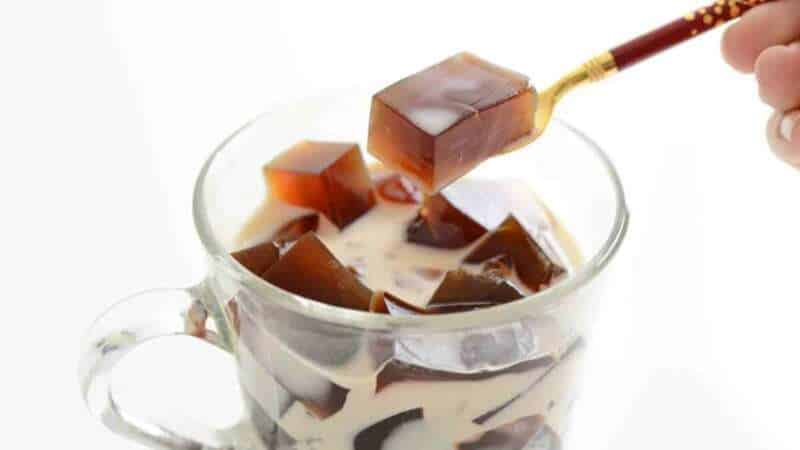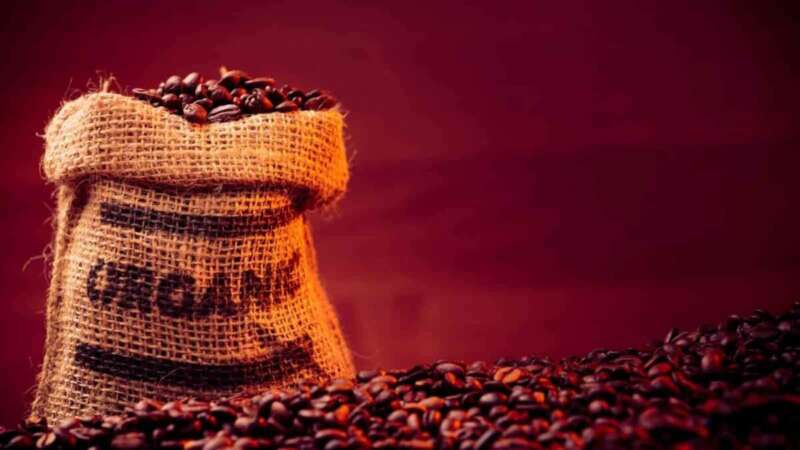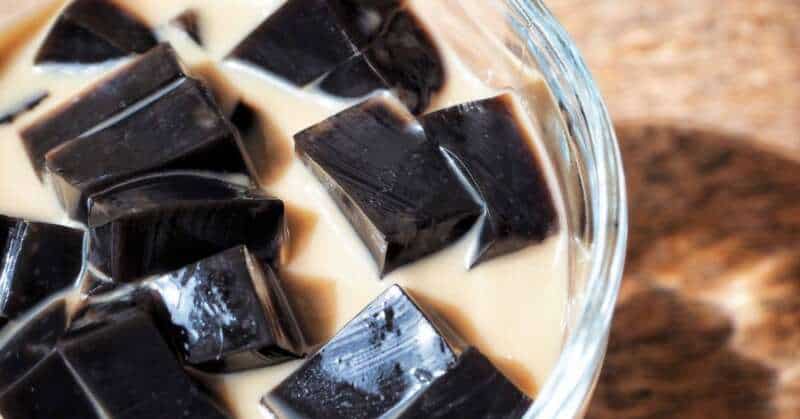Combining hot coffee, sugar, gelatin, and whipped cream into a sweet dessert is never going to be super healthy, but coffee jelly has some serious health benefits not found in other desserts, and the recipe is versatile enough that you can cut out the calories and caffeine if you want to.
Coffee jelly is perfectly safe and healthy in moderation. In most cases, it’s a simple mixture of gelatin and sweetened coffee, but it’s usually served with heavy cream which can be high in calories. Depending on the coffee used to make it, coffee jelly may contain a small amount of caffeine.
In this article, we’ll learn the ins and outs of coffee jelly, look at the caffeine and fat content and how it compares to other coffee, and learn a few tricks to amend your tasty coffee jelly recipe to make it a bit healthier.
Is Coffee Jelly Safe?
Coffee jelly is perfectly safe, there are only two ingredients (coffee and gelatin) plus optional cream and sweeteners.
The only thing to be aware of is that coffee jelly is usually served with heavy whipped cream, which is unsuitable for anyone with a dairy intolerance.

Is Coffee Jelly Unhealthy?
Coffee jelly is a sweetened coffee dessert, usually served with thick dairy cream. There’s nothing in it that’s particularly unhealthy, but it does contain caffeine and the cream it’s usually served with contains a lot of calories.
There are far more unhealthy coffee-based desserts and beverages, including bulletproof coffee and Irish coffee.
Coffee Jelly Calories
A typical 50g serving of coffee jelly on its own has fewer than 15 calories. This is because the amount of sweetened coffee in a serving of jelly is roughly 1/5th of a cup, or 50ml. Coffee jelly dessert is made from sweetened coffee and either gelatin powder or agar powder to thicken it.
Coffee jelly is usually served with heavy whipped cream, which contains approximately 170 calories for a single 50g serving.
Heavy cream can be substituted with a healthier alternative such as condensed milk or low-fat cream to reduce the calories of this delicious dessert.
Caffeine
The caffeine content in a single serving of coffee jelly is fewer than 15mg per 50g serving. To put this into perspective, a single shot of espresso contains 68mg of caffeine. The caffeine content is so low because each serving of jelly is made from approximately 1/5th of a cup of coffee.
You can easily remove the caffeine content from coffee jelly by using decaf coffee in the recipe.
Related: Check out our post, Which Starbucks Coffee Has the Most Caffeine? to see which Starbucks beverages give the most kick.

Health Benefits of Coffee Jelly
Coffee jelly is a sweet dessert so it isn’t usually something people eat for health benefits, however, coffee jelly shares a few of the health benefits that regular coffee has, including an abundance of antioxidants and an energy-boosting effect from caffeine.
Health Benefits of Antioxidants
Coffee is well-known for its abundance of healthy antioxidants, which are crucial for human health.
Antioxidants help slow aging and can help lower the risk of some serious illnesses including heart disease and stroke.
Health Benefits of Caffeine
Coffee jelly isn’t as high in caffeine as instant coffee, containing less than 15mg of caffeine in a 50g serving, compared to 68g in a single shot of espresso.
Although caffeine isn’t recommended for young children, it’s a common stimulant for adults and can help boost your energy when you need to concentrate.
According to Harvard University, consumption of low doses of caffeine (<300mg) resulted in increased alertness, energy, and ability to concentrate while avoiding the possible downsides of excess caffeine.
Is Coffee Jelly Healthier than Coffee?
In general, a regular cup of instant coffee is less unhealthy than a coffee jelly dessert, but it depends on how you make your coffee and how you serve coffee jelly.
A latte or a mocha may have a higher calorie count than coffee jelly because of the milk content, but coffee jelly is often served with heavy whipped cream which is calorie-dense too.
Compared with a cup of coffee, coffee jelly may have less or more caffeine, depending on the recipe used. It’s possible to make both regular coffee and coffee jelly with decaffeinated coffee.
Table – Coffee Types by Caffeine and Fat Content Comparison
| Coffee Type | Caffeine Content | Energy |
|---|---|---|
| Espresso (1 shot / 30ml) | 68mg Caffeine | 2.7 Calories |
| Latte (1 cup / 240ml) | 86mg Caffeine | 103 Calories |
| Mocha (1 cup / 240ml) | 82mg Caffeine | 159 Calories |
| Cappuccino (1 cup / 240ml) | 86mg Caffeine | 65 Calories |
| Coffee Jelly* (1 serving / 50g) | 12.5mg Caffeine | 12.7 Calories |
| Coffee Jelly* with Cream (50g serving + 50g cream) | 12.5mg Caffeine | 182.7 Calories |
*Coffee jelly recipe = 2tbsp (14g) gelatin powder per 2 cups (480ml) sweetened coffee
Sources: USDA Food Nutrition Database (Espresso, Latte, Mocha, Cappuccino, Sweetened Coffee, Gelatin, Heavy Cream)
How To Make Coffee Jelly Healthier?
Coffee jelly isn’t inherently unhealthy, it’s just that if you eat too much of it the calories will start adding up, and the caffeine content might be undesirable if you’re eating it later in the day.
Luckily, coffee jelly is a very versatile recipe, and you can adjust the ingredients to suit your needs.
Some methods to make coffee jelly a bit healthier include:
- Use Arabica instead of Robusta coffee to reduce the caffeine content
- Use decaffeinated coffee to remove the caffeine altogether
- Serve with less cream, or use a low-fat cream alternative to reduce the calories
- Use less sweetener when making coffee jelly to reduce the calories

FAQs
Is Coffee Jelly Vegan?
Coffee jelly usually isn’t vegan, since the traditional recipe includes gelatin and dairy cream, both of which are animal-derived products.
Gelatin comes from the tendons and cartilage that surround animal bones (usually beef) and cream is made from cow’s milk.
It’s possible to make a similar tasting dessert without using animal products by replacing the gelatin with a vegan gelling agent such as Agar Agar (which is made from seaweed) and substituting the dairy cream for a vegan alternative such as coconut cream.
How is Coffee Jelly Made?
Coffee jelly is usually made with gelatin powder and sweetened coffee. Coffee is slowly heated on a stove while gelatin powder is added to thicken the mixture.
Once the gelatin has been added, the mixture is allowed to cool at room temperature then refrigerated. As the coffee/gelatin mix cools down, it becomes a dark coffee-flavored jelly.
Coffee jelly is typically served with heavy cream and eaten as a dessert.
Is Coffee Jelly Safe for Children?
Coffee jelly is safe for children over 12 but should not be given to younger children due to its caffeine content.
The American Academy of Pediatrics recommends that children under 12 should avoid consuming caffeine and that older children aged 12 to 18 should limit their caffeine intake to 100mg per day at most.
Caffeine is known to have many negative health effects which are especially apparent in young children, including increased blood pressure, anxiety, and a disrupted sleep schedule.
Conclusion – Should You Avoid Coffee Jelly?
Coffee jelly is a delicious sweet treat that coffee lovers will enjoy. It’s easy and fun to make, and there’s nothing in it that’s harmful.
Coffee jelly recipes can be easily adjusted to suit your taste by altering the strength and sweetness of the coffee you use to make the jelly. Optionally, you can also use decaffeinated coffee if you don’t want the caffeine and a low-fat cream alternative if you want to reduce the calories!
